When you think of Austria, one of the first images that may come to mind is that of a picturesque alpine landscape with people dressed in traditional attire. The Austria National Dress, known as a dirndl, holds a significant place in the country's culture and has captivated people worldwide. In this article, we will explore the history, components, styles, and cultural significance of the Austrian national dress, the dirndl.
History of Austrian National Dress
The roots of the dirndl can be traced back to the 19th century, when it originated as the everyday clothing worn by women in the Alpine regions of Austria. Initially, the dirndl served as a practical outfit for the rural population, featuring sturdy fabrics and simple designs. Over time, it evolved into a symbol of cultural pride and identity, representing the rich heritage of Austria.
Traditional Components of a Dirndl
A dirndl typically consists of four essential components: the bodice, blouse, skirt, and apron. The bodice is a fitted garment that shapes the upper body and often features intricate embroidery or embellishments. The blouse, usually made of lightweight cotton or linen, adds a touch of femininity with its delicate frills or lace details. The skirt is voluminous and falls below the knee, showcasing various patterns and colors. Lastly, the apron, tied around the waist, completes the ensemble and provides an additional layer of decoration.
Different Styles of Dirndls
The dirndl exhibits a wide range of styles, with variations influenced by different regions and occasions. Each design reflects the unique cultural heritage of its respective area. In Austria, you can find region-specific dirndls, such as the Salzburg dirndl or the Tyrolean dirndl, each characterized by distinctive colors, patterns, and accessories. Moreover, dirndls are available in both festive and everyday styles, allowing women to dress accordingly for various events and celebrations.
Significance of Dirndls in Austrian Culture
Dirndls hold immense significance in Austrian culture, serving as a symbol of tradition, social identity, and national pride. Wearing a dirndl showcases a connection to local customs and values, creating a sense of belonging within communities. The dirndl is commonly worn during festivals, weddings, and other special occasions, where it plays an integral role in preserving cultural heritage and fostering a strong sense of camaraderie among Austrians.
Modern Interpretations of Austria National Dress
While rooted in tradition, the dirndl has also evolved to adapt to modern times. Contemporary fashion trends have influenced the design and styling of dirndls, resulting in innovative variations that still maintain the essence of the traditional dress. Fashion designers have embraced the dirndl, incorporating it into their collections and showcasing it on runways. This fusion of traditional elements with modern aesthetics has given rise to dirndl-inspired designs that appeal to a broader audience beyond Austria.
The Popularity of Dirndls Beyond Austria
The allure of dirndls extends far beyond the borders of Austria. These enchanting dresses have gained international recognition and captivated people from different cultures. The unique charm of the dirndl, with its flattering silhouette and vibrant colors, has made it a sought-after fashion statement at various events and celebrations worldwide. Dirndl festivals and gatherings are organized in different countries, providing an opportunity for enthusiasts to come together and celebrate the beauty of this traditional attire.
Tips for Wearing and Caring for Austria National Dress
If you're intrigued by the beauty of dirndls and plan to add one to your wardrobe, here are some helpful tips for wearing and caring for your cherished dress:
Proper Fit and Styling: Ensure that your dirndl fits you well, especially around the bodice and waist. The skirt should fall at the right length for your height. Experiment with different blouse styles and accessories to personalize your look.
Maintenance and Storage: Follow the care instructions provided by the manufacturer. Typically, dirndls are made of high-quality fabrics that require gentle handling. Hand washing or dry cleaning is recommended to preserve the colors and embroidery. When storing your dirndl, protect it from sunlight and moisture to prevent any damage.
Conclusion
Austria's national dress, the dirndl, embodies the country's rich cultural heritage and serves as a symbol of pride and tradition. Its history, regional variations, and enduring popularity have made it an iconic fashion statement. The dirndl's charm has transcended borders, captivating people around the world. Whether worn during festive occasions or embraced as a unique fashion choice, the dirndl continues to enchant with its timeless elegance.
FAQs
Q: Can men wear dirndls too?
A: While the dirndl is traditionally worn by women, there are male versions of traditional Austrian attire, such as lederhosen, which are popular among men.
Q: Are dirndls only worn during Oktoberfest?
A: While dirndls are commonly associated with Oktoberfest, they are also worn on various other occasions, such as weddings, folk festivals, and cultural celebrations.
Q: Are dirndls considered formal attire in Austria?
A: Dirndls can be worn in both formal and informal settings, depending on the style and occasion. They are often seen as a respectful and elegant choice for special events.
Q: Can I customize the design of a dirndl?
A: Yes, many dirndl boutiques offer customization options, allowing you to choose specific fabrics, colors, and accessories to create a personalized dirndl.
Q: Is it appropriate to wear a dirndl outside of Austria?
A: Yes, dirndls can be worn and appreciated worldwide. They have become a fashionable choice for individuals who admire their unique aesthetic and cultural significance.
References:
- Smith, J. (2018). Austrian National Dress: Dirndl and Lederhosen. Culture Trip. Link
- Gruber, B. (2020). Dirndl: A Traditional Austrian Dress. Planet Austria. Link
- Fischer, K. (2019). The Austrian Dirndl: Tradition with a Modern Twist. Austria.info. [Link](https://www.austria.info/uk/things-to-do/food-and
